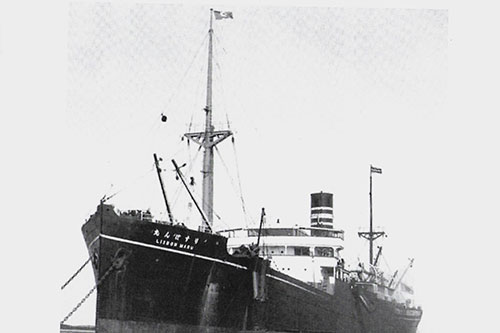Sunday October 3rd 2021

The armed Japanese freighter Lisbon Maru which sank in 1942 while carrying 1,816 British POWs from Hong Kong to Japan.
Today over 100 former members of The Royal Scots, traditionally the regiment for Edinburgh & the Lothians, their families, relatives and friends gathered at the National Memorial Arboretum in Staffordshire to attend the dedication of two memorials.
The first memorial, a five-ton block of Aberdeenshire granite, sited close to the Armed Forces Memorial at the centre of the Arboretum, bears a bronze plaque inscribed with the badges of the Regiment and the words:
‘In Memory of all those who served their Sovereign and Country in The Royal Scots (The Royal Regiment), 1st Regiment of Foot and Right of the Line, 1633-2006. Nemo Me Impune Lacessit.’
The last phrase, in Latin, is the Regimental, and Scottish, motto – No one provokes me with impunity.
After a short address from Brigadier George Lowder, President of the Regimental Association, the monument was dedicated by The Rev Iain May, Minister of South Leith Parish Church and Chaplain to the Association. The Stone supplements the main Regimental Monument sited below The Mound in West Princes Street Gardens, Edinburgh, which was dedicated in 1953 and updated in 2008.
The choice of The National Memorial Arboretum for this additional Memorial, was to commemorate all former members of the Regiment, wherever they came from, including many from overseas, and highlight the Regiment’s service as The British Army’s senior and oldest infantry Regiment before it was merged into The Royal Regiment of Scotland in 2006.
After the dedication of The Royal Scots Memorial the attendees moved to join several hundred other representatives from The Royal Navy and other Regiments and Corps for a service dedicating a memorial to the 828 prisoners of war (POWs) who died 79 years ago in the sinking of the armed Japanese freighter Lisbon Maru in 1942 while carrying 1,816 British POWs from Hong Kong to Japan.
Included amongst the POWs on board were 373 members of the 2nd Battalion The Royal Scots who had become POWs upon the surrender of Hong Kong on Christmas Day 1941. Of this number, 181 men (48.5%) died, killed by their guards or drowned as a result of the ship’s sinking. Many more died as POWs from their treatment, working subsequently as forced labourers in Japan in support of Japanese war effort.
President of the Royal Scots Regimental Association, Brigadier George Lowder said: “After 2 years of planning and preparation by a wide range of Royal Scots volunteers, it is great to see this project come to fruition, providing a suitable Royal Scot rallying point at the National Memorial Arboretum, Staffordshire, particularly for the many Royal Scots who live south of the border. It is a fitting memorial to all Royal Scots and especially poignant to be unveiled on the same day as the Lisbon Maru memorial.”
Son of Private James Gow, Dr Iain Gow, Musselburgh, Edinburgh said:
“When we were growing up, like most Far East POWs, Dad never really talked about his experiences. We knew vaguely he’d been in Hong Kong, on the Lisbon Maru, and Kobe, but not the extent of the horror he’d experienced or witnessed. It never cast a shadow over our childhood, Christmas was always quiet, he preferred to celebrate Hogmanay and New Year, for reasons which are now obvious to us.”
Dr Iain Gow’s father, 3054415 Pte James Gow, survived the Lisbon Maru sinking. Subsequently he was a POW in Kobe Camp, forced to work in the Docks. On repatriation, Pte Gow remained in The Royal Scots and was back in the fray at the end of the War. Iain Gow is very much involved in the History of the Hong Kong, Lisbon Maru, POWs and he retains contacts in Hong Kong. He recently obtained some artefacts collected from the Battlefield in Hong Kong, which he donated to The Royal Scots Museum.
Son of Private Victor Thomson, Vic Thomson, Mold, North Wales said:
“My father, Victor Thomson joined the 2nd Battalion, The Royal Scots in November 1933 and so began a journey eastward around the world. First stop India and then, in 1938, moving to Hong Kong. He fought defending Hong Kong before surrendering on Christmas Day 1941 to become a POW.
“He survived the torpedoing and sinking of the Lisbon Maru before being transported to Kobe, Japan for forced labour in the docks. Liberation in August 1945 began the final leg of the round-the-world trip, journeying home via Manilla and Canada. Subsequently, he married his devoted wife, Alice Smith, who without his wife’s care, would have struggled to recover from his ordeal.”
Tweet Share on Facebook